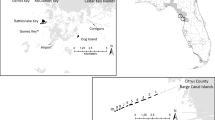Abstract
Trends in abundance of the 28 most common species of coastal birds on Mustang Island, Texas, were assessed for a 29-year period (1979–2007) during which the study area experienced a substantial increase in human activity. Ten of the 28 species examined declined significantly (P < 0.05) over the study period. Six of these were larids (herring gull, Forster’s tern, royal tern, gull-billed tern, Caspian tern, black skimmer), which exhibited declines in mean abundance of 53% to 88%. Other significant species declines were the great blue heron (39% decline) and the shorebirds Wilson’s plover (63%), red knot (54%), and black-bellied plover (34%). Four species showed significant increases in local abundance. Mean number of people on the beach increased fivefold during the study period. This unique dataset allows for an extremely rare assessment of bird populations in direct relation to human disturbance and may have implications for managing coastal birds worldwide.






Similar content being viewed by others
References
Bart, J., S. Brown, B. Harrington, and R.I.G. Morrison. 2007. Survey trends of North American shorebirds: Population declines or shifting distributions? Journal of Avian Biology 38: 73–82.
BirdLife International. 2009. State of the world’s birds 2009: indicators for our changing world. Cambridge: BirdLife International.
Brown, S., C. Hickey, B. Harrington, and R. Gill (eds). 2001. The U.S. Shorebird Conservation Plan, 2nd ed. Manomet, MA: Manomet Center for Conservation Studies.
Burger, J. and M. Gochfeld. 1991. Black skimmer: social dynamics of a colonial species, 355. New York: Columbia University Press.
Cornelius, C., S.A. Navarrete, and P.A. Marquet. 2001. Effects of human activity on the structure of coastal marine bird assemblages in central Chile. Conservation Biology 15: 1396–1404.
Crossett, K. M., T. J. Culliton, P. C. Wiley, T. R. Goodspeed. 2004. Population trends along the coastal United States: 1980-2008. Coastal Trends Report Series. U.S. Department of Commerce, National Oceanic and Atmospheric Administration, National Ocean Service. pp. 54
De Graaf, R.M., N.G. Tilghman, and S.H. Anderson. 1985. Foraging guilds of North American birds. Environmental Management 9: 493–536.
Gaston, K.J., T.M. Blackburn, and K.K. Goldewijk. 2003. Habitat conversion and global avian biodiversity loss. Proceedings of the Royal Society, London B 270: 1293–1300.
International Union for Conservation of Nature and Natural Resources. 2006. 2006 IUCN Red List of Threatened Species; www.redlist.org.
McCrary, M. D. and M. O. Pierson. 2000. Influence of human activity on shorebird beach use in Ventura County, California. Proceedings of the Fifth California Islands Symposium. 124-127.
Morrison, R. I. G., 1991. Research requirements for shorebird conservation. Trans. 56th North American Wildlife and Natural Resource Conference 1991: 473-480.
Myers, J.P., R.I.G. Morrison, P.Z. Antas, B.A. Harrington, T.E. Lovejoy, M. Sallaberry, S.E. Senner, and A. Tarak. 1987. Conservation strategy for migratory species. American Scientist 75: 19–26.
Sauer, J. R., J. E. Hines, and J. Fallon. 2005. The North American Breeding Bird Survey, Results and Analysis 1966–2005. Version 6.2.2006. USGS Patuxent Wildlife Research Center, Laurel, MD.
Schmid, D., D.J.H. Grémillet, and B.M. Culik. 1995. Energetics of underwater swimming in the Great Cormorant (Phalacrocorax carbosinensis). Marine Biology 123: 875–881.
Schreiber, E.A. and J. Burger. 2002. Seabirds in the marine environment. In Biology of marine birds, ed. E.A. Schreiber and J. Burger, 1–16. Boca Raton, FL: CRC.
Şekercioğlu, C.H., G.C. Daily, and P.R. Ehrlich. 2004. Ecosystem consequences of bird declines. Proceedings of the National Academy of Sciences 101: 18042–18047.
Sharp, G.D. and D.R. McLain. 1993. Fisheries, El Nino−Southern Oscillation and upper-ocean temperature records: An eastern Pacific example. Oceanography 6: 13–21.
Skagen, S. K., P. B. Sharpe, R. G. Waltermire, M. B. Dillion. 1999. Biogeographic profiles of shorebird migration in midcontinental North America. Biological Science Report 3. U.S. Department of the Interior, U.S. Geological Survey, Springfield, Virginia, USA.
Thomas, G.H., R.B. Lanctot, and T. Székely. 2006. Can intrinsic factors explain population declines in North American breeding shorebirds? A comparative analysis. Animal Conservation 9: 252–258.
Acknowledgments
The authors thank Drs. G. J. Holt, K. H. Dunton, and A. F. Ojanguren for their helpful suggestions and critical review of earlier drafts of this manuscript. We also thank two anonymous reviewers and an associate editor for their helpful comments. C. R. F. would like to thank his wife and family for their encouragement. Funding for analysis of the data was provided by the Sibyl Ranfranz and Kenneth F. Wells Endowed Excellence Fund in Marine Science. Contribution 1511 of The University of Texas Marine Science Institute.
Author information
Authors and Affiliations
Corresponding author
Additional information
The results of this manuscript are the original work of the authors and have not been submitted for publication elsewhere.
Rights and permissions
About this article
Cite this article
Foster, C.R., Amos, A.F. & Fuiman, L.A. Trends in Abundance of Coastal Birds and Human Activity on a Texas Barrier Island Over Three Decades. Estuaries and Coasts 32, 1079–1089 (2009). https://doi.org/10.1007/s12237-009-9224-2
Received:
Revised:
Accepted:
Published:
Issue Date:
DOI: https://doi.org/10.1007/s12237-009-9224-2




